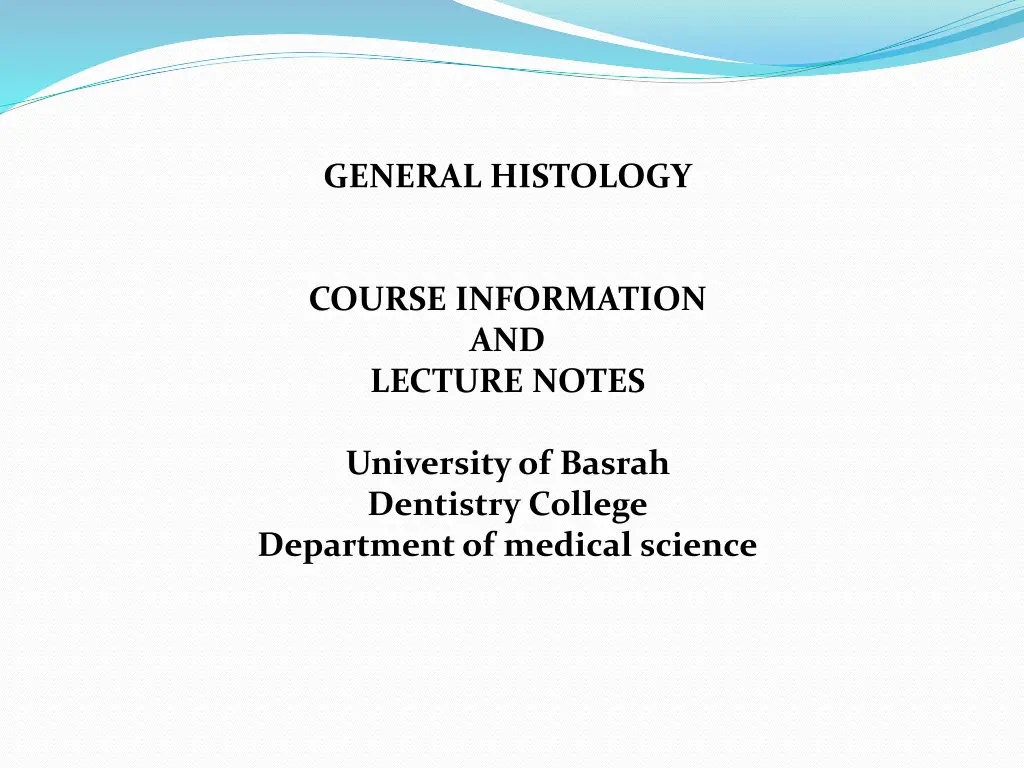
Exploring Histology: Understanding Tissue Structure and Function
"Discover the importance of histology in studying tissue structure and function, from cell level to organ systems. Learn about the uses of histology in education, diagnosis, forensic science, and more. Explore the different types of tissues found in the human body and their functions. Gain insights into epithelial tissue and its vital roles. Enhance your knowledge of histological techniques and their applications in various fields."
Download Presentation

Please find below an Image/Link to download the presentation.
The content on the website is provided AS IS for your information and personal use only. It may not be sold, licensed, or shared on other websites without obtaining consent from the author. If you encounter any issues during the download, it is possible that the publisher has removed the file from their server.
You are allowed to download the files provided on this website for personal or commercial use, subject to the condition that they are used lawfully. All files are the property of their respective owners.
The content on the website is provided AS IS for your information and personal use only. It may not be sold, licensed, or shared on other websites without obtaining consent from the author.
E N D
Presentation Transcript
GENERAL HISTOLOGY COURSE INFORMATION AND LECTURE NOTES University of Basrah Dentistry College Department of medical science
Course Description: Histology is the study of tissue structure, extending from the level of the individual cell, through organs to organ systems. Histology is obviously related to Cell Biology (Cytology) and to Anatomy; it also forms the structural basis for understanding function (Physiology) and is the preparation for the study of abnormal structure and function (Pathology). - Particular skills which will be emphasized are: 1- Classification of tissues 2- Recognition of specific features and the application of the criteria of classification 3- Most importantly, the relationship between structure and function.
What is Histology? Histology: it is the scientific study of the fine detail of biological cells and tissues using microscopes to look at specimens of tissues that have been carefully prepared using special processes called "histological techniques".
What are the uses of histology? 1. Education histology helps students learn about the microstructures of human and animal biological tissues. 2. Diagnosis histology may be studied in detail to enable medical or veterinary experts to learn more about the patient's condition and hence perhaps understand its causes and make recommendations for treatment or management of the condition. 3. Forensic histology can help clarify the cause of sudden unexpected deaths and other issues in forensic science. 4. Autopsy Biological tissues from a deceased person or animal can be studied using histological techniques enabling experts to learn about the circumstances and possibly cause of death. 5. Archaeology Study of biological cells and tissues recovered from archaeological sites can provide information about history, even ancient history.
What are tissues? Tissues are groups of cells with a common structure (form) and function (job). How many types of tissue found in human s body? There are four main tissues in the body: 1. Epithelial tissue 2. Connective tissue 3. Muscular tissue 4. Nervous tissue.
EPITHELIAL TISSUE: Epithelium: is the cellular covering of internal and external surface of the body, including the lining vessels and other small cavities. What are the functions of the epithelium? 1. Protection from the outside world skin. 2. Absorbs stomach and intestinal lining (gut) 3. Filters the kidney 4. Secretes forms glands
What are the characteristics of epithelium? 1. They closely attached to each other forming a protective barrier. 2. They always have one free (apical) surface open to outside the body or inside (cavity) an internal organ. 3. They always have basal section attached to underlying connective tissue. 4. They have no blood vessels but can soak up nutrients from blood vessels in connective tissue underneath. 5. They can have lots of nerves in it (innervated). 6. They are very good at regenerating (fixing itself). i.e. sunburn, skinned knee.
Basement Membrane (BM) Most epithelial cells are separated from the connective tissue by a sheet of extracellular material called the basal lamina. The basal lamina is visible only with the electron microscope, where it appears as a dense layer,20 100 nm thick, consisting of a delicate network of very fine fibrils.
Functions of Basal laminae: 1. supporting the cells. 2. They provide a barrier that limits or regulates the exchange of macromolecules between connective tissue and cells of other tissues. 3. The basal lamina is also able to influence cell polarity, regulate cell proliferation and differentiation by binding with growth factors, influence cell metabolism, and serve as pathways for cell migration. 4. The basal lamina seems to contain the information necessary for certain cell-to-cell interactions. 5. The presence of the basal lamina around a muscle cell is necessary for the establishment of new neuromuscular junctions.
The basal lamina is subdivided into two or three layers: 1. a pale lamina lucida next to the epithelium, 2. a lamina densa, then the deeper 3. a lamina fibroreticularis (less consistently visible)
TYPES OF EPITHELIAL TISSUE Covering and Lining Epithelial Tissue Types of Epithelial Tissue (in this classification) Classification by Cell Shape: Squamous Cuboidal Columnar Transitional Classification by Arrangement of Layers: Simple Epithelium Simple squamous epithelium/(lungs) Simple cuboidal epithelium/ (kidneys) Nonciliated simple columnar epithelium/(small intestine) Ciliated simple columnar epithelium/(trachea lining) Stratified squamous epithelium/( mouth lining) Stratified cuboidal epithelium/ (salivary glands, sweat glands) Stratified columnar epithelium/(male reproductive tract) Transitional epithelium/ (bladder) Stratified Epithelium Pseudostratified columnar Pseudostratified columnar epithelium/ ( tubular glands of Epithelium the endometrium in females.) Glandular Epithelial Tissue Endocrine Glands Exocrine Glands (Tissue of) Endocrine Glands (Tissue of) Exocrine Glands
Ciliated epithelium: Ciliated epithelium is a region of epitheliumconsisting of columnar or cuboidal cells bearing hair-like appendages that are capable of beating rapidly. Ciliated epithelium performs the function of moving particles or fluid over the epithelial surface in such structures as the trachea, bronchial tubes, and nasal cavities. It often occurs in the vicinity of mucus-secreting goblet cells. These hairs, called cilia, move back and forth to help move particles out of our body.

